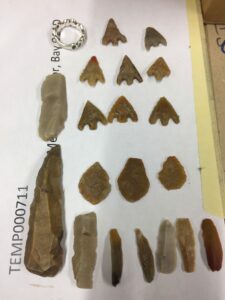
We are all accustomed to the joy of museums. They provide great centres for getting to know a new location or understand the history of a holiday destination. They offer a wonderful way to spend a rainy day, and are brilliant places to occupy children. Many provide a mean cup of coffee. Occasionally, we even venture inside to look at specific aspects of their collections: an assemblage of prehistoric stone tools; the finds from a particular site; a single iconic artefact; a new display or exhibition. From an early age I learnt about ‘museum feet’.
But museums are so much more than the contents of their well-polished cases. One aspect we rarely stop to consider is the important role they play as repositories for the material which we, as archaeologists, excavate. As anyone who has participated in a dig knows, finds, and related material, accumulate rapidly. Yet the immediacy of discovery and unpicking the meaning of what we find is such that we devote little thought to what becomes of our discoveries once the processes of analysis are complete. Most countries have well-tested methods for allocating finds to an institution that will look after them (here is the Scottish practice) and, perhaps, even put them on display. There may be rival competitors, for example between local museums and those in larger centres of population, but the systems are there. Many of us take this safeguarding role of the museum for granted.
It is not without problems. We rarely consult the local museums before we dig, we simply expect them to house increasing numbers of finds without question. Those finds have to be cared for in appropriate conditions. It is not always an easy task to resource or undertake. Museum collections are like icebergs: while it is, for the most part, only the tip that impinges on our consciousness, the main body is highly significant.
As archaeologists we tend to focus on collecting ‘new’ data, but I am increasingly aware of the benefits of considering older, pre-existing, material. There must, for example, be millions of stone tools safely packed away around the country – all available for study (with a little bit of bureaucracy). Here in Scotland, we have found that it is well worthwhile re-examining these old collections. In many cases advancing methods and new narratives mean that we are recognising significant contributions to our understanding of Scottish prehistory that it was just not possible to pick up before. It is a useful way to expand our knowledge without the expense (and destruction) of excavation. It is good professional practice.
Museums are great places. We have sadly been unable to experience them in person for most of the last twelvemonths, but that is not to say that they have simply been hibernating. Many have developed enhanced virtual experiences. All have been keeping an eye on their materials. Strange to say, the customer may not always be at the front of their thoughts: the collections are far more important. Whether we visit for simple joy, to teach and educate ourselves or others, to research, to find a coffee, or to get out of the rain, they deserve our support. The next time you find yourself near to one, I recommend popping inside to see what there is to offer.
You must be logged in to post a comment.